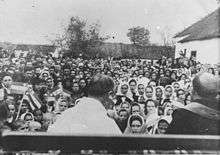Catholicisation
Catholicisation refers mainly to the conversion of adherents of other religions into Catholicism, and the system of expanding Catholic influence in politics. Catholicisation was a policy of the Holy See through the Papal States, Holy Roman Empire, Habsburg Monarchy, etc. Sometimes this process is referred to as re-Catholicization although in many cases Catholicized people had never been Catholics before.[1]
The term is also used for the communion of Eastern Christian churches into the Roman Catholic Church; the Eastern Catholic Churches that follow the Byzantine, Alexandrian, Armenian, East Syrian, and West Syrian Rites, as opposed to the Roman Catholic Latin Rite.
Historical examples

All Albanians were Orthodox Christians until the mid-13th century[2] when the Ghegs converted to Catholicism as a mean to resist the Orthodox Serbs.[3]
Serbs are predominantly and traditionally Eastern Orthodox. Since the many migrations into the Habsburg Monarchy beginning in the 16th century, there has been efforts to Catholicize the community. The Orthodox Eparchy of Marča became the Catholic Eparchy of Križevci after waves of conversion in the 17th and 18th centuries. Notable individuals active in the Catholicisation of Serbs in the 17th century include Martin Dobrović, Benedikt Vinković, Petar Petretić, Rafael Levaković and Ivan Paskvali.
See also
Further reading
- Marina Caffiero; Lydia G. Cochrane (2012). Forced Baptisms: Histories of Jews, Christians, and Converts in Papal Rome. University of California Press. ISBN 978-0-520-25451-0.
- G. J. Cuming (18 December 2008). The Mission of the Church and the Propagation of the Faith: Papers read at the Seventh Summer Meeting and the Eighth Winter Meeting of the Ecclesiastical History Society. Cambridge University Press. ISBN 978-0-521-10179-0.
- Tadhg Ó hAnnracháin (15 October 2015). Catholic Europe, 1592-1648: Centre and Peripheries. Oxford University Press. ISBN 978-0-19-927272-3.
- The Holy Roman Empire, 1495-1806: A European Perspective. BRILL. 25 July 2012. ISBN 978-90-04-22872-6.
- Lazo M. Kostić (1981). The Holocaust in the "Independent State of Croatia": An Account Based on German, Italian and Other Sources. Liberty.
- Atlagić, M. (2008). "Katoličenje Srba na Kosovu i Metohiji u XVII vijeku" (PDF). Baština (25): 137–147. (in Serbian)
- Veljko Đ. Đurić (1991). Prekrštavanje Srba u Nezavisnoj Državi Hrvatskoj: prilozi za istoriju verskog genocida. Alfa.
- Gojo Riste Dakina (1994). Genocide Over the Serbs in the Independent State of Croatia: Be Catholic Or Die. Institute of Contemporary History.
- Sima Simić (1958). Prekrštavanje Srba za vreme Drugog svetskog rata. Grafički zavod.
References
- ↑ Peter Hamish Wilson (2009). The Thirty Years War: Europe's Tragedy. Harvard University Press. p. 357. ISBN 978-0-674-03634-5.
- ↑ Hugh Chisholm (1910). Encyclopædia Britannica: a dictionary of arts, sciences, literature and general information. Encyclopædia Britannica. p. 485. Retrieved 18 July 2013.
The Roman Catholic Ghegs appear to liave abandoned the Eastern for the Western Church in the middle of the 13th century
- ↑ Leften Stavros Stavrianos (January 2000). The Balkans Since 1453. C. Hurst & Co. Publishers. p. 498. ISBN 978-1-85065-551-0. Retrieved 17 July 2013.
Originally, all Albanians had belonged to the Eastern Orthodox Church... Then the Ghegs in the North adopted ... to better resist the pressure of Orthodox Serbs.